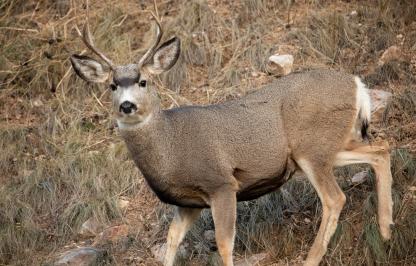The Wyoming Game and Fish Department has recovered peregrine falcons from a cliff outside of Lander. Historically, these falcons have been some of the most visible peregrines in the state and have generated much local interest.
This spring, through regular monitoring, nongame biologists identified the nest ledge the Sinks Canyon peregrine pair chose to nest on this year. Biologists observed courtship displays, incubation behaviors, and prey deliveries to the female while she was nesting. In late June, observations of the female bird ceased; however, the male remained in the area but was no longer seen visiting the nest ledge. After it was determined the nesting attempt was unsuccessful and that human presence would not be a disturbance to the birds, the Game and Fish flew a drone to take images of the ledge and seek answers as to what may have happened to the female bird. Following biologists' review of the images, an expert climber from the Central Wyoming Climbers Alliance volunteered their time to descend to the ledge and collect the nest contents.
A deceased female peregrine falcon and two dead chicks were collected from the ledge. Physical trauma was ruled out through an initial X-ray before sending the birds to the Game and Fish Wildlife Health Lab. The Lab determined the birds to be unsuitable for testing to examine for cause of death due to the length of time that had passed since they died.
Peregrines feed almost entirely on other birds, increasing their exposure to any bird-related illnesses. This year the Wildlife Health Lab has seen a high level of bird deaths due to avian influenza.
“While the cause of death remains unknown for the Sinks Canyon peregrines, avian influenza is one possibility as are many other avian diseases,” said Game and Fish Wildlife Health Lab Supervisor Hank Edwards.
Peregrines are serially monogamous and are most loyal to their nesting territory. When a member of the pair dies or fails to return to the territory, the other will find a new mate.
“It is believed that the male will return to this nesting territory in the spring of 2023 and there is a high likelihood that he will be able to court another female to occupy it with him. Similar to other places in the state we expect there are peregrines waiting in the wings to pair with this male again. We are hopeful that the territory will once again produce chicks in the near future,” said Game and Fish Nongame Supervisor Zack Walker.
The public’s reporting of suspected avian influenza deaths is important in tracking this disease and its impacts on wildlife. Avian influenza deaths are expected to increase this fall as birds migrate back through the state. The public is encouraged to continue to report finding large birds, including raptors, that are displaying symptoms or that are found dead. Also, be on the lookout for groups of five or more deceased smaller birds, such as sparrows or pigeons. You can report online or to your local Game and Fish office.
Dead peregrine falcons recovered from cliff outside of Lander
3073322688



